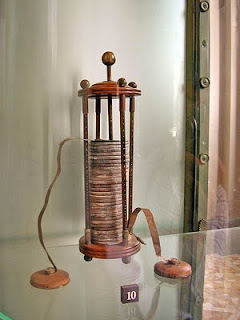The word "phlogiston" came from the ancient Greek word φλογιστόν ("burning up") and was promulgated by German scientists beginning in the 17th century. The notion had probably been around much longer because the idea was a very intuitive one. Phlogiston theory taught the existence of an element called phlogiston, a substance without color, odor, taste, or mass. Phlogiston was liberated when something burned or slowly rusted. Think of what you feel in front of an open flame. Not really so far-fetched, the notion was close to our modern notion of energy consumption, in so far as we suppose substances like fuels have "energy content." We speak of hydrocarbon's energy content in BTUs as if it were something we could distill and put in a bottle.
Phlogiston was a German notion and was undone by men like Antoine Lavoisier who showed that metals increased their mass when they burn or rust, inconsistent with something being lost or given up. Unfortunately, Lavoisier lost his head in the French Revolution for his royalist sympathies. A dead cat bounce for Phlogiston occurred around the turn of the 19th century, just after water electrolysis was discovered.
 |
| Alessandro Volta's Pile |
It was with no little surprise that we found the hydrogen extricated at the contact with one wire, while the oxigen [sic] fixed itself in combination with the other wire at a distance of almost two inches.What actually happened depended on the type of metal wire used: when they used copper, hydrogen gas evolved at one wire while the other wire became "fixed with oxygen" meaning it turned to copper oxide (greenish blue). But with platinum or gold wires, hydrogen gas evolved cleanly at one wire while oxygen gas evolved cleanly at the other electrode. The great puzzle was not that the two different gases were produced, but rather that they were produced at different electrodes. It seemed to everyone that if the gases both came from the decomposition of water they should both appear at the same place.
Now the notion that hydrogen and oxygen were distinct elements was not universally accepted. It was not settled science. One of the doubters was a German named Johann Ritter. Ritter was no slouch.* He repeated the Nicholson and Carlisle experiments and concluded that it was impossible for the gases to be produced from the decomposition of water since there was no way that a gas could travel through one wire, through the pile, and out through the other wire. The truth, Ritter argued, was that:
Water is an elementIn Ritter's view, "oxygen" was just water plus positive electricity and "hydrogen" was just water plus negative electricity. He nearly set science back 2000 years. That water was an element and electricity was like phlogiston was ancient thinking. Great minds, including Michael Faraday, puzzled over water electrolysis for years. Bear in mind that in the early 1800's nobody had yet thought that water could ionize into H+ and OH-. The proton (and the electron) had not yet been discovered. But the Germans ultimately lost the argument.
We now understand that water is consumed at both electrodes and electrons flow into one electrode and out the other:
At one electrode we have: 2H2O + 2e- ----> H2(g) + 2OH-
At the other electrode: 2H2O - 4e- ----> O2(g) + 4H+
I remember this stuff by recalling the origin of the word "oxygen" which means "acid-forming." The electrode which forms oxygen also forms acid. Of course the H+ and the OH- swam the two inches back towards each other in Nicholson's experiment and remade neutral water, and completed the circuit.
_________________________
*Ritter was no slouch:
"William Herschel discovered infrared radiation because thermometers, which had recently been developed in Europe, showed a higher temperature just beyond the red end of the visible spectrum of sunlight. The German chemist Johann Wilhelm Ritter (1776-1810), after hearing about Herschel’s discovery from 1800, identified another “invisible” radiation which we now know as ultraviolet (UV) in 1801. He experimented with silver chloride since blue light was known to cause a greater reaction to it than did red light, and he found that the area just beyond the violet end of the visible spectrum showed the most intense reaction of all." reference

No comments:
Post a Comment